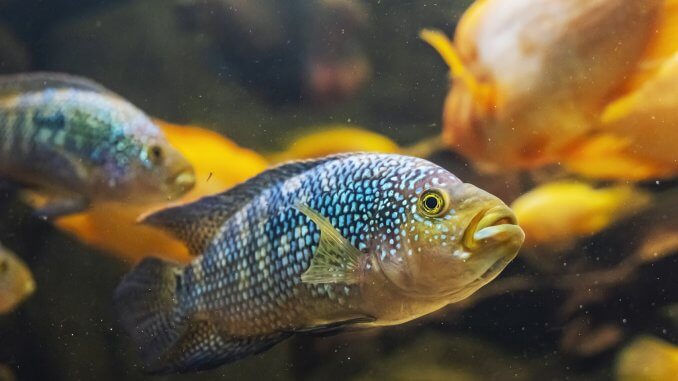
The Jack Dempsey fish is a freshwater species of cichlid. Jack Dempsey fish have aggressive natures, like their namesake, the legendary heavyweight boxing champion, Jack Dempsey.
Despite their feisty personalities, Jack Dempsey fish are popular among aquarists due to their beautiful iridescent colors.
TABLE OF CONTENTS
Jack Dempsey Fish Facts & Overview
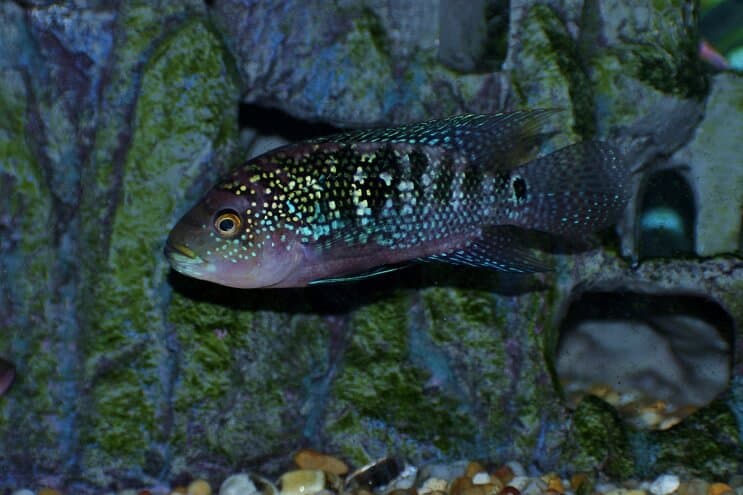
| Scientific name: | Rocio octofasciata |
| Common names | Jack Dempsey cichlid |
| Distribution: | Belize, Honduras, Mexico, and Guatemala |
| Size: | 10–15 inches |
| Life expectancy: | 8–10 years |
| Color: | Blue, purple, green, pink, or gray, with bright specs |
| Diet: | Carnivore |
| Temperament: | Aggressive |
| Minimum tank size: | 80 gallons |
| Temperature: | 72–86°F (22–30°C) |
| pH: | 6.0–7.0 |
| Hardness: | 9–20 dGH |
| Care level: | Intermediate |
| Breeding: | Egg-layer |
Origin
Jack Dempsey cichlid fish predominantly live in slow-moving freshwater rivers in Mexico, Belize, Honduras, and Guatemala. Humans have introduced Jack Dempsey fish to warm waters outside of the fish’s native regions.
The Jack Dempsey fish’s preferred habitat has a year-round warm climate, with a good source of insects, worms, crustaceans, and small fish for the cichlids to feed on.
Adult Size & Lifespan
When fully grown, Jack Dempsey fish reach up to 15 inches long. In captivity, the fish grow to about half this length. Male Jack Dempsey fish are bigger than females. Males grow up to eight inches long, and females grow up to six inches long.
The average lifespan of a Jack Dempsey fish is 8–10 years.
Availability
Jack Dempsey fish are widely available in pet stores and online, in a range of colors. The average cost of a Jack Dempsey fish is $15–$45, depending on the fish’s colors and markings.
You can find Jack Dempsey fish in the following online stores:
- LiveAquaria: Common Jack Dempsey fish, electric blue Jack Dempsey fish, pink Jack Dempsey fish
- Aquatic Arts: Electric blue Jack Dempsey fish
Appearance & Behavior
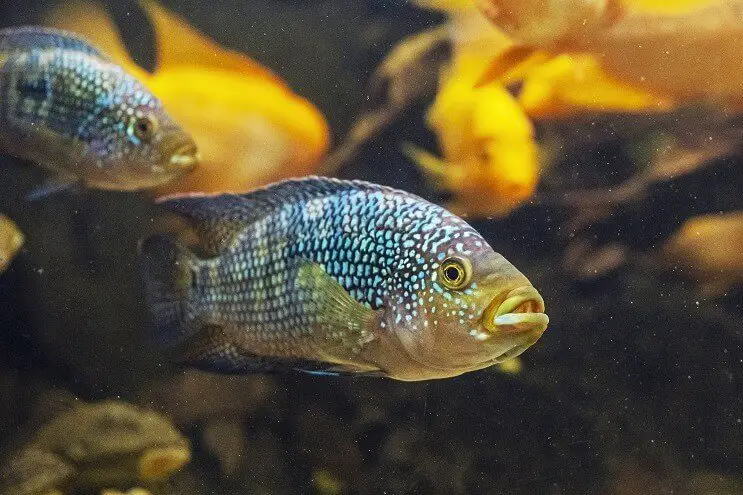
Jack Dempsey fish are medium-sized, colorful fish with shimmering scales. They have aggressive personalities and aren’t recommended for beginner fishkeepers.
Colors, Patterns, Fins, and Sex Differences
Jack Dempsey fish are long-finned cichlids with large, oval bodies. Males are bigger and have longer fins than females.
These fish are found in a variety of colors, including blue, pink, green, silver, and purple. The color of a Jack Dempsey fish changes as the fish ages. Young Jack Dempsey fish are pale gray with flecks of green, while adult Jack Dempsey fish are purple with blue, green, or white flecks.
A popular variety of the Jack Dempsey fish is the electric blue Jack Dempsey, a bright-blue fish that is smaller and less aggressive than the common Jack Dempsey cichlid.
The colors of a Jack Dempsey fish become temporarily duller than usual when the fish is stressed, and become darker and bolder during the breeding season.
Typical Behavior
Jack Dempsey fish are aggressive fish that are known to chase, bite, or bully small or vulnerable fish. Male Jack Dempsey fish are especially territorial and will claim territories in the tank and chase off fish that invade their space.
The middle and the low sections of the tank are preferred by Jack Dempsey fish. These cichlids are most active during the daytime hours and spend most of their time lurking in caves and behind plants.
Jack Dempsey Fish Care & Tank Requirements
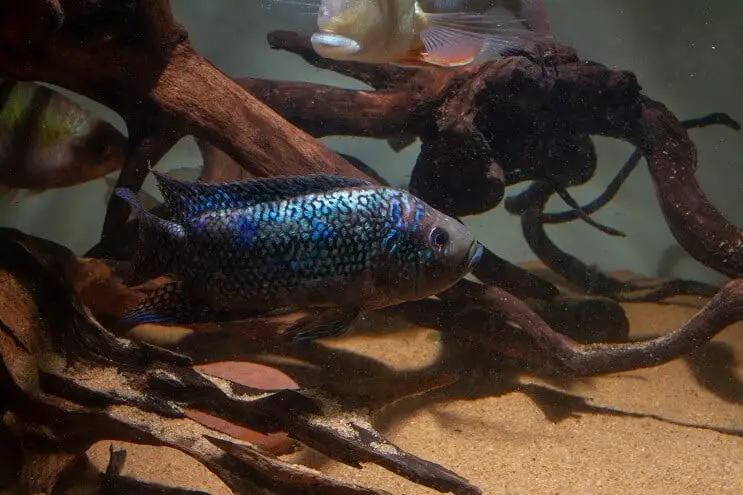
Caring for a Jack Dempsey fish is challenging because of the fish’s aggressive nature. People with experience looking after other cichlids will find it easier than beginners to raise Jack Dempsey fish.
Jack Dempsey fish need a warm, clean tank environment with suitable tank mates to prevent disease, stress, and conflict.
Feed Jack Dempsey fish a carnivorous, high-protein diet.
Habitat and Tank Requirements
The natural habitat of Jack Dempsey fish is slow-moving waters, including freshwater lakes, rivers, canals, and swamps. The fish are used to warm, slightly acidic, murky waters with low light levels, a sandy, muddy substrate, and plenty of vegetation.
Provide a similar environment in the tank to ensure your Jack Dempsey fish feel comfortable in captivity.
The minimum tank size required for a single Jack Dempsey fish is 80 gallons, and each additional fish requires an extra 55 gallons of water. Adding multiple Jack Dempsey fish to your tank reduces aggression. Providing a large tank for Jack Dempsey fish ensures that all fish have enough space to claim their own territories.
Choose a sandy, muddy substrate that closely matches the substrate in the fish’s wild habitat. Add plenty of caves and hollow decorations to the tank for the Jack Dempsey fish to hide in.
Deep-rooted and floating plants are important in a Jack Dempsey fish tank. Choose hardy plants like anubias and Java fern to prevent the fish from pulling the plants out of the substrate. Floating plants like hornwort can be used to mimic the low-light waters in the wild, providing shaded areas in sections of the tank.
Avoid bright lighting in the tank, which causes Jack Dempsey fish to hide.
Tank Conditions
The ideal tank conditions for Jack Dempsey fish are:
| Water type: | Slightly acidic, slow-moving freshwater |
| Tank size: | Minimum 80 gallons, and an extra 55 gallons of water for one extra Jack Dempsey fish |
| Water temperature: | 72–86°F |
| Substrate: | Fine sand or mud |
| Tank setup: | Caves, floating plants, hollow decorations |
| Acidity: | 6.0–7.0 pH |
| Water hardness: | 9–20 dGH |
| Filter: | Yes, to keep the water clean and provide a slow-moving current |
| Bubbler: | Not necessary because the fish prefer a slow current |
| Lighting: | Yes, but lighting should be dim to mimic the murky waters in the fish’s natural habitat |
| Water heater: | Yes, to maintain a tropical water temperature |
Aside from maintaining ideal water parameters, ensure that Jack Dempsey fish are housed in a large, dimly-lit tank with plenty of decorations that the fish can claim as their territories.
Disease
Although Jack Dempsey fish are hardy, there are several diseases that result from housing the fish in poor water conditions:
Hole in the Head
Hole in the head, caused by a protozoan called Hexamita, is a potentially fatal disease that occurs in unclean aquariums. This disease causes small pimples and pits on the fish’s head, which grow to large, white holes when the disease progresses. Appetite loss, white feces, weight loss, and lethargy are common symptoms of hole in the head.
Speak to your veterinarian about medications to treat hole in the head.
Ich
Ich, or white spot disease, is caused by Ichthyophthirius multifiliis, and produces tiny white sprinkles on the fish’s body. This disease gets into home aquariums through fish, plants, and live foods that are introduced to the tank without proper cleaning or sanitation. Fish with Ich rub their bodies against rough surfaces in the tank and appear lethargic.
To treat Ich, transfer the fish into a separate tank with the same water conditions as the home tank, then gradually raise the water temperature by a couple of degrees to speed up the protozoan parasite. Medications like Ich-X can be used to kill I. multifiliis.
Tank Mates
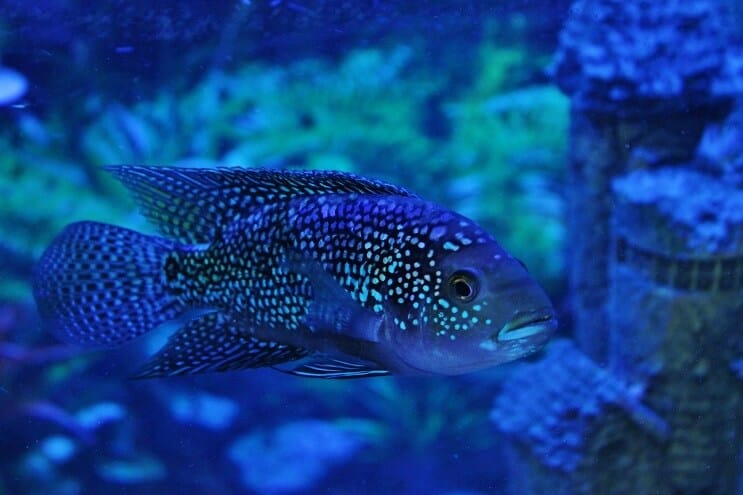
Because Jack Dempsey fish have aggressive personalities, your choice of tankmates is restricted to similarly-sized fish with similar temperaments to Jack Dempsey fish.
Don’t house them with shy, nervous fish that they are likely to bully. Avoid small tank mates, such as tetras, and non-fish tank mates, such as shrimp and snails, because Jack Dempsey fish view these creatures as food.
Great tank mates for Jack Dempsey fish include:
- Other Jack Dempsey fish (buying pairs or small groups of this species reduces aggression)
- Oscar fish
- Mbuna cichlids
- Angelfish
- Clown loaches
- Convict cichlids
- Plecostomus catfish
- Electric blue acaras
- Silver dollar fish
Diet and Feeding
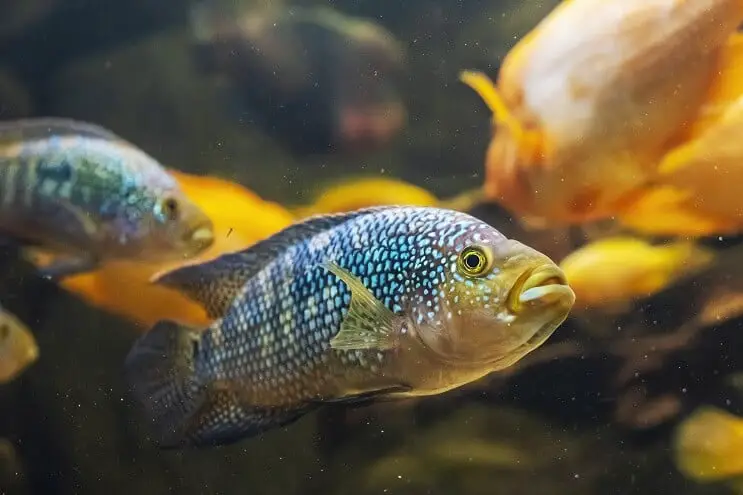
In the wild, Jack Dempsey fish eat a carnivorous diet of insects, worms, small fish, and crustaceans.
Make sure your fish receive plenty of protein in captivity from a combination of dried fish flakes and live or frozen foods.
Pellets and flakes designed for cichlids can provide the bulk of the Jack Dempsey fish’s diet. Supplement these processed foods with live or frozen bloodworms, brine shrimp, crickets, fruit flies, and grasshoppers.
Don’t feed plant-based foods to Jack Dempsey fish because these foods don’t meet the fish’s nutritional needs.
Feed them a pinch of food twice per day. Provide enough food that the fish can eat within two minutes. Discard leftover food to prevent overfeeding and to keep the tank clean.
Juvenile Jack Dempseys should be fed up to three times per day to support the fish’s growth.
Breeding
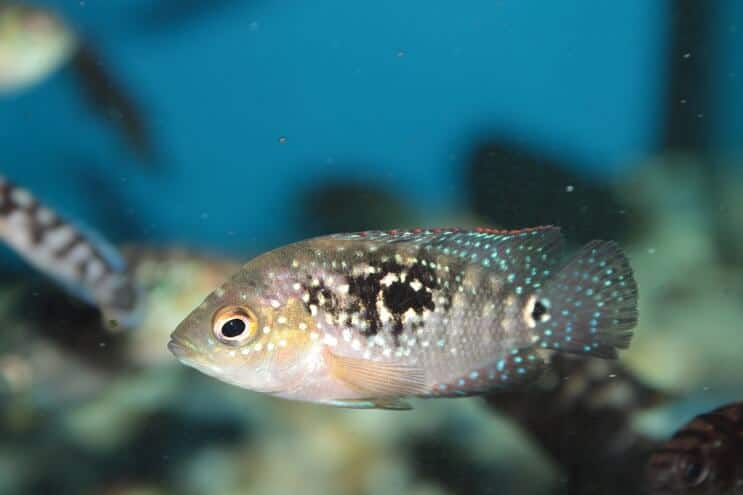
Breeding Jack Dempsey fish is easy. They become sexually mature once they have grown to eight inches long.
To breed Jack Dempsey fish, follow the instructions below:
- Select a healthy male and female fish for breeding. The largest males in the tank have the most success in breeding.
- Place the chosen breeding pair in a breeding tank, separated by a divider, with identical water conditions to the home tank. Increase the water temperature to 84°F and feed the fish a diet of bloodworms to induce breeding.
- The male and female’s colors will darken when the fish are ready to breed, at which point the divider can be removed from the tank. Ensure that the female’s colors have darkened — if the female isn’t interested in breeding, she could be harassed to death by the male.
- The male will chase the female and perform a mating dance to show off to the female. The male will prepare a sheltered pit or flat surface to lay the eggs.
- The pair will spawn inside a cave and the female will lay up to 500 eggs.
- The female will guard the eggs for up to three days until the eggs hatch.
- Feed the parents cichlid fish food. The parents will eat enough food for themselves and crush some of the food to feed the fry, until the fry are free-swimming.
- When the fry are three days old, remove the parents to prevent them from eating the fry or preparing to breed again. Feed the fry baby brine shrimp, commercial fry food, or microworms until the fish are old enough to eat adult food, or once they reach four inches long.
Jack Dempsey fish mate for life, so it’s easy to breed the same parents several times throughout their lifespan.
Should You Get a Jack Dempsey Fish for Your Aquarium?
Jack Dempsey fish are lively fish with an aggressive streak.
Consider getting a Jack Dempsey fish if you can prepare a new tank especially for this fish species. Don’t get one if you plan to add the fish to an established tank with small or vulnerable fish.
Despite their tough, boisterous personalities, Jack Dempsey fish are colorful, hardy fish that are entertaining to watch in a home aquarium.

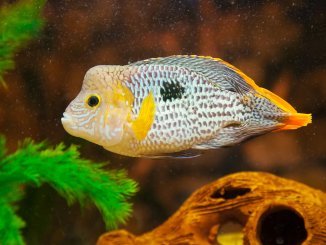
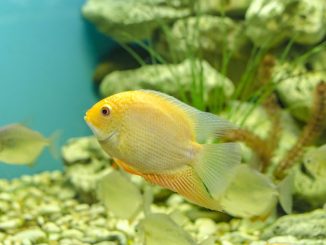
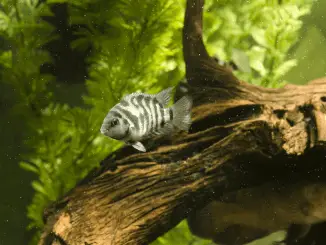
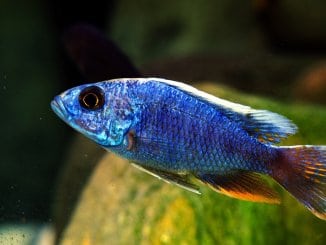
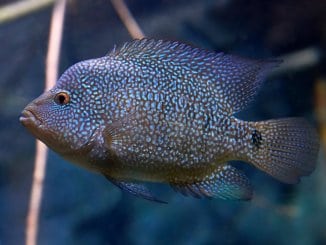
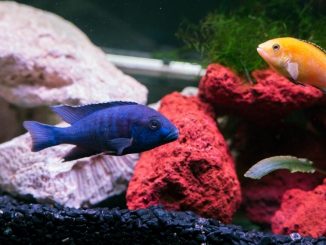
I find the recommendation on tank size is a bit extreme. I have two JD’s and one is in a 10 gallon and the other in a 29 and I’ve had them healthy and happy for almost 3 years now.
I’ve just lost my two male electric blue jack dempseys after 12 years. One was always smaller than the other, I guess that’s how they got along! I found them to be tame, allowing you to stroke their heads after feeding but shy as they hid most of the day. They enjoyed the company of my severum. I’ve just bought two more, hoping I’ve got a male and a female this time! They live with a red-tailed shark and some other cichlids.
I have JD babies, over 150. I am also looking to sell my electric blue parents. Pls con tat me if you are interested